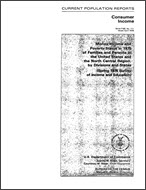Money Income and Poverty Status in 1975 of Families and Persons in the United States and the North Central Region, by Divisions and States (Spring 1976 Survey of Income and Education)
Money Income and Poverty Status in 1975 of Families and Persons in the United States and the North Central Region, by Divisions and States (Spring 1976 Survey of Income and Education)
Introduction
This report contains estimates for families, unrelated individuals, and persons by money income and poverty status in 1975 for the United States, the North Central Region, and the divisions and States within the region. The estimates were obtained from the Survey of Income and Education (SIE), which was conducted between April and July 1976 by the Bureau of the Census. This report updates 1970 census money income and poverty estimates for these areas. Similar reports are available for each of the remaining three major census regions in the Nation.
In order to facilitate geographical comparisons, this report consists of three basic tables comprising six pages of data for all States and divisions within the region. The first table contains income distributions for families and unrelated individuals cross-classified by a broad range of socioeconomic and demographic characteristics similar in content to data published from the Current Population Survey (CPS). These characteristics include residence, tenure, type of family, size of family, number of related children under 18 years old, number of earners, age, race, occupation, work experience, and education. The second table contains a selection of similar data for persons, by sex. In the third table, data for the poverty population are shown for a broad range of characteristics. In addition to many of the characteristics mentioned above, the third table includes information on duration of unemployment, main reason for not working, type of income, subsidized housing of renters, and living arrangements for unrelated individuals.
In constructing a report of this nature, decisions had to be made on the selection of data to be shown at each geographical level. Although a broad range of information is shown at the State level, it was decided not to show extensive cross-classifications of these data by race and Spanish origin at the State level. This approach would have resulted in statistically unreliable data for many of the States with only a small number of observations by race and Spanish origin. The basic tables, however, are shown by race and Spanish origin for divisions, regions, and the United States. All derived measures (means, medians, poverty rates, etc.) were suppressed for a given distribution if the base had less than 60 sample cases. However, if the base is small, or if the standard error is large, care should be exercised when making comparisons between categories. Additional discussion of these considerations can be found in the appendix in the section, "Source and Reliability of the Estimates."
A Note on Language
Census statistics date back to 1790 and reflect the growth and change of the United States. Past census reports contain some terms that today’s readers may consider obsolete and inappropriate. As part of our goal to be open and transparent with the public, we are improving access to all Census Bureau original publications and statistics, which serve as a guide to the nation's history.
Related Information
-
PublicationIncome & Poverty Status of Families & Persons in the Northeast RegionThis report presents statistics for families and persons by money income and poverty status in 1975 in the United States and the Northeast Region, by States.
-
PublicationIncome & Poverty Status of Families & Persons in the South RegionThis report presents statistics for families and persons by money income and poverty status in 1975 in the United States and the South Region, by States.
-
PublicationIncome & Poverty Status of Families & Persons in the West RegionThis report presents statistics for families and persons by money income and poverty status in 1975 in the United States and the West Region, by States.
Others in Series
Publication
Publication
Publication




